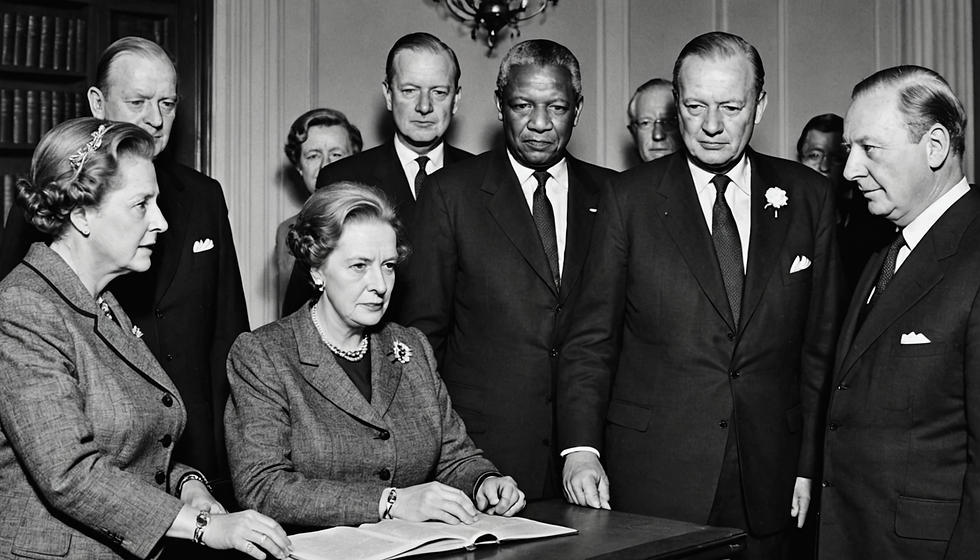The "Stockdale Paradox" in Negotiations
- R.M. Boylan

- Feb 17
- 4 min read
Updated: Feb 21
Stockdale Paradox
R.M. Boylan, BSc. M.A, Leadership Studies
Research on Levels of Development in Leaders

Application of Stockdale Paradox in Negotiations, Conflict, and Peace
The Stockdale Paradox can be a powerful tool in negotiations and conflict resolution:
Realistic Assessment: Negotiators should assess the situation honestly, acknowledging challenges while preparing for potential outcomes.
Maintaining Hope: Keeping faith in the possibility of a successful resolution can motivate parties to continue seeking solutions.
Building Resilience: Encouraging a mindset that combines realism with hope can help parties navigate difficult negotiations more effectively.
Scholars like William Ury, co-founder of the Harvard Negotiation Project, emphasize the importance of understanding both positions in negotiations while fostering a hopeful outlook (Ury, 1991).
Why Optimism Can Lead to Poor Planning and Failure
Being overly optimistic can lead to poor planning and failure due to several reasons:
Underestimating Risks: Optimists may overlook potential obstacles, leading to inadequate preparation.
Lack of Contingency Plans: An optimistic outlook can result in a failure to develop backup plans, making it difficult to respond to unforeseen challenges.
Complacency: Excessive optimism can breed complacency, causing individuals or teams to neglect necessary actions or assessments.
Research by psychologist Barbara Fredrickson suggests that while positive emotions are beneficial, they should be balanced with realistic assessments to avoid pitfalls (Fredrickson, 2001).
Meaning for High Stake Negotiators, Business people, leader
For Stockdale and his fellow POWs, the paradox highlighted two critical aspects of survival:
Confronting the Brutal Facts: Stockdale emphasized the importance of acknowledging the dire circumstances without losing hope. This meant fully understanding the reality of their situation, including the possibility of never returning home. This research was also found in the 2nd World War where people that held onto hope survived better.
Maintaining Faith: Despite the grim reality, Stockdale maintained a deep-seated belief that he would ultimately prevail and return to his family. This dual approach was pivotal for psychological resilience.
What Stockdale discovered about optimism vs. hope grounded in harsh reality
Stockdale's perspective was that those who could not face the brutal facts often succumbed to despair, while those who maintained a naive optimism without acknowledging the harsh realities fell short in their survival strategies.
The Stockdale Paradox, named after Admiral James Stockdale, illustrates the balance between maintaining unwavering faith and confronting the brutal facts of reality. In the context of Stockdale's experiences as a prisoner of war in Vietnam, it is observed that:
Optimists: Often died first. They tended to set unrealistic expectations for their release and were unable to cope with the harsh realities of their situation.
Pessimists: Typically succumbed second. Their negative outlook led to despair and a lack of hope, which ultimately affected their will to survive.
Realists (those who embraced the Stockdale Paradox): Survived the longest. They acknowledged the severity of their circumstances while maintaining hope for eventual freedom. This balance allowed them to endure the hardships they faced.
The key takeaway from the Stockdale Paradox is that a combination of realism and hope is essential for resilience in challenging situations.
Who They Were and How They Survived-The team
Admiral James Stockdale was one of the highest-ranking officers captured during the Vietnam War. His fellow POWs included other military personnel who faced similar brutal conditions. To survive, they employed various strategies:
Mutual Support: They formed bonds and supported each other emotionally and physically.
Maintaining a Sense of Identity: Many prisoners focused on their roles and values, which helped them retain a sense of purpose.
Creating a Culture of Resistance: They engaged in acts of defiance against their captors, which bolstered morale.
Optimism, Pessimism, and Pessimism with Hope for achieving the end goal
The Stockdale Paradox illustrates the distinction between different mindsets:
Optimism: This is the belief that everything will work out without necessarily addressing the realities of the situation. Optimists often underestimate challenges and may fail to plan adequately.
Pessimism: This mindset is characterized by a negative outlook, often leading to despair and inaction. Pessimists may succumb to hopelessness, which can hinder survival.
Pessimism with Hope: This approach acknowledges the difficulties while still believing in a positive outcome. It fosters resilience and encourages realistic planning.
Research by psychologist Martin Seligman supports the idea that realistic optimism, which combines hope with a clear understanding of challenges, is crucial for resilience (Seligman, 1990).
Application in Negotiations, Conflict, and Peace
The Stockdale Paradox can serve as an effective instrument in negotiations and resolving conflicts:
Realistic Assessment: Negotiators need to evaluate the situation truthfully, recognizing difficulties and preparing for possible results.
Maintaining Hope: Believing in the potential for a successful outcome can inspire parties to persist in finding solutions.
Building Resilience: Fostering an attitude that blends realism with optimism can assist parties in handling challenging negotiations more successfully.
Scholars like William Ury, co-founder of the Harvard Negotiation Project, emphasize the importance of understanding both positions in negotiations while fostering a hopeful outlook (Ury, 1991).
Why Optimism Can Lead to Poor Planning and Failure
Being overly optimistic can lead to poor planning and failure due to several reasons:
Underestimating Risks: Optimists may overlook potential obstacles, leading to inadequate preparation. In negotiations this can lead to not developing proper contingency plans and trade-offs leading to failed partnerships due to over confidence and optimism. Scanning the periphery for threats and obstacles is almost impossible for a person who is optimistic.
Lack of Contingency Plans: An optimistic outlook can result in a failure to develop backup plans, making it difficult to respond to unforeseen challenges.
Complacency: Excessive optimism can breed complacency, causing individuals or teams to neglect necessary actions or assessments.
Research by psychologist Barbara Fredrickson suggests that while positive emotions are beneficial, they should be balanced with realistic assessments to avoid pitfalls (Fredrickson, 2001).
References
Boylan, R.M. (2006-2009). Conflicts and considerations comparing Abraham Maslow's hierarchy of needs to Jane Loevinger's model of ego development for assessing the level of development of a leader. M.A. Leadership Studies.
Seligman, M. E. P. (1990). Learned Optimism: How to Change Your Mind and Your Life. Vintage Books.
Ury, W. (1991). Getting Past No: Negotiating Your Way from Confrontation to Cooperation. Bantam Books.
Fredrickson, B. L. (2001). The role of positive emotions in positive psychology: The broaden-and-build theory of positive emotions. American Psychologist, 56(3), 218-226.





Comments